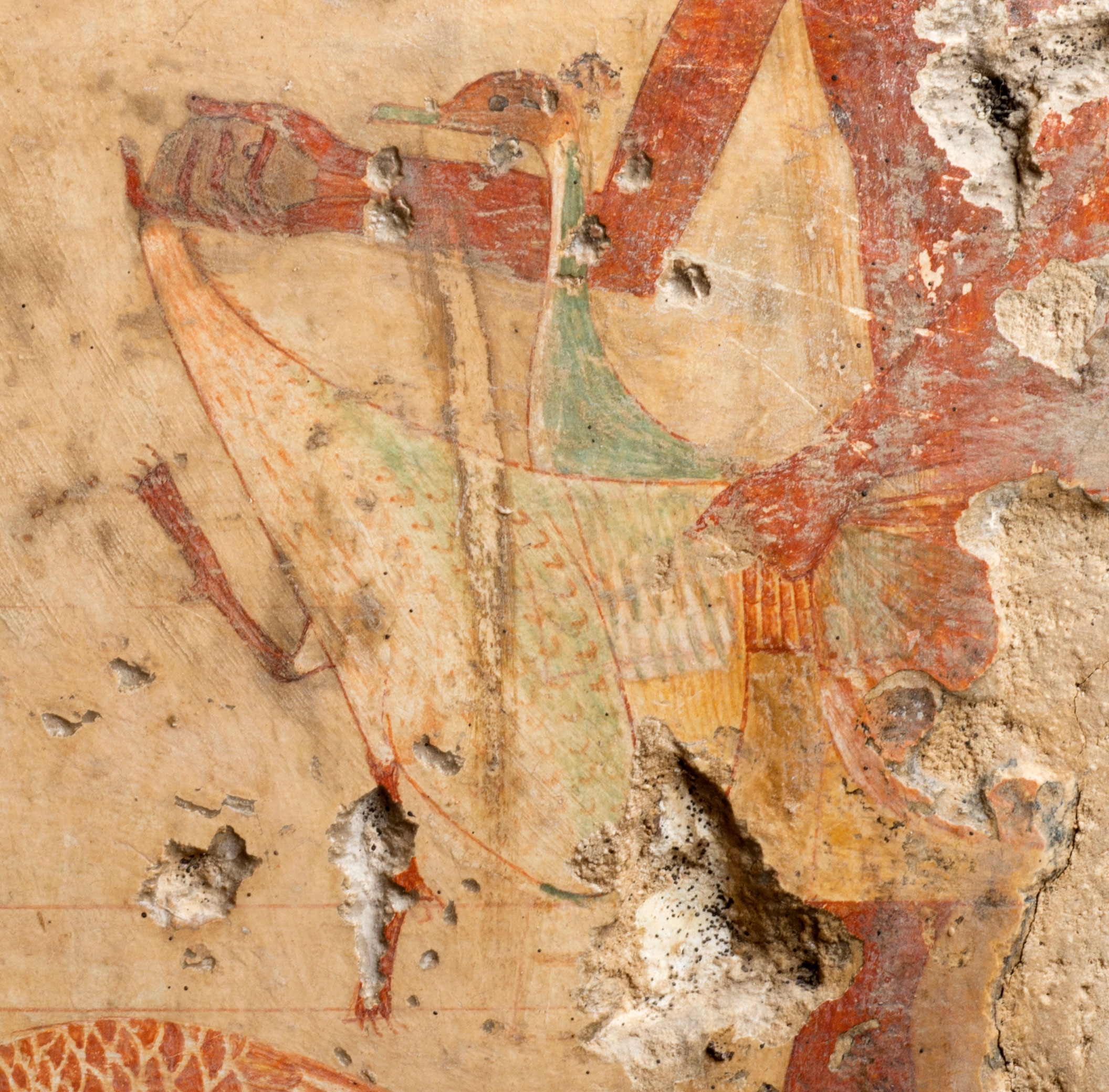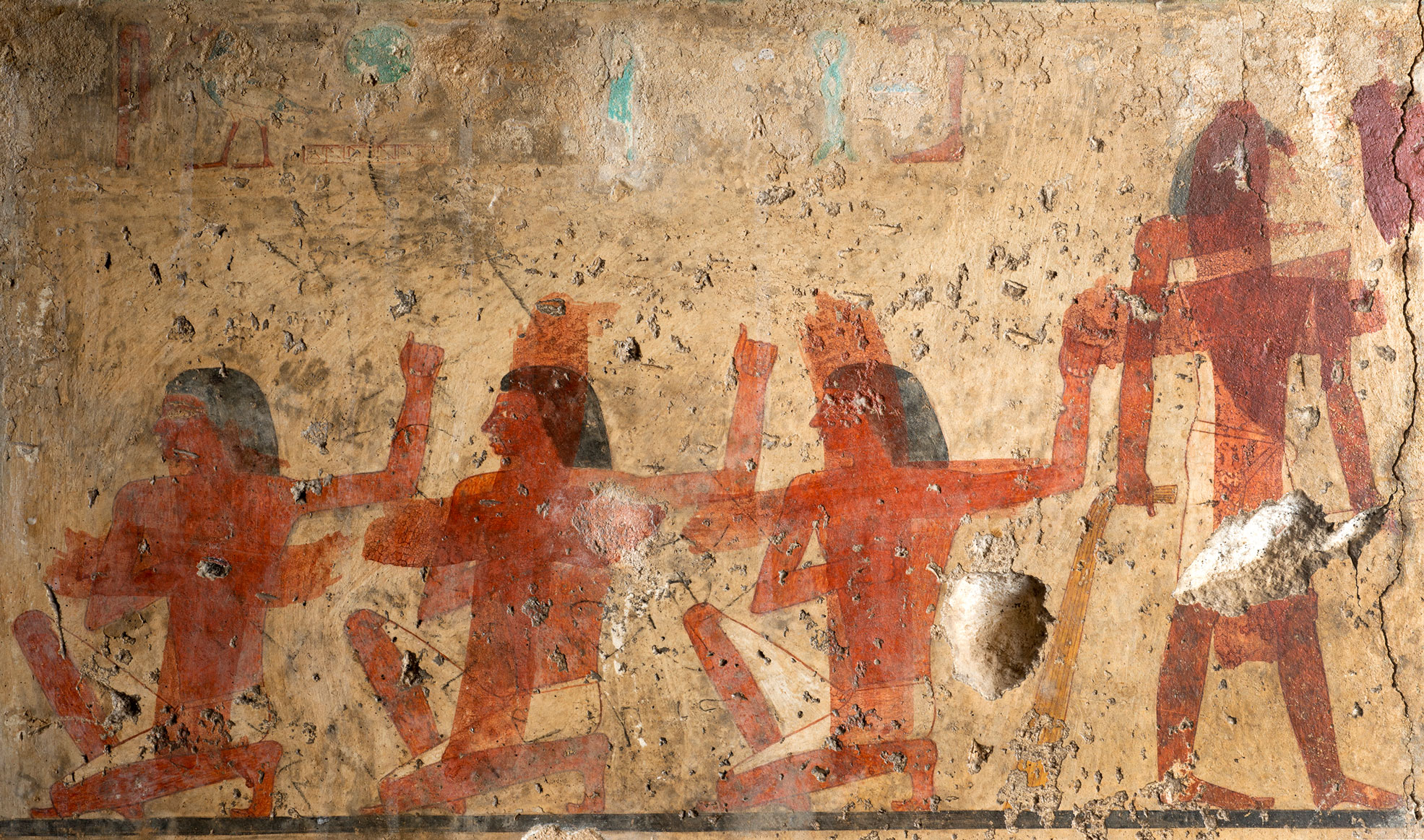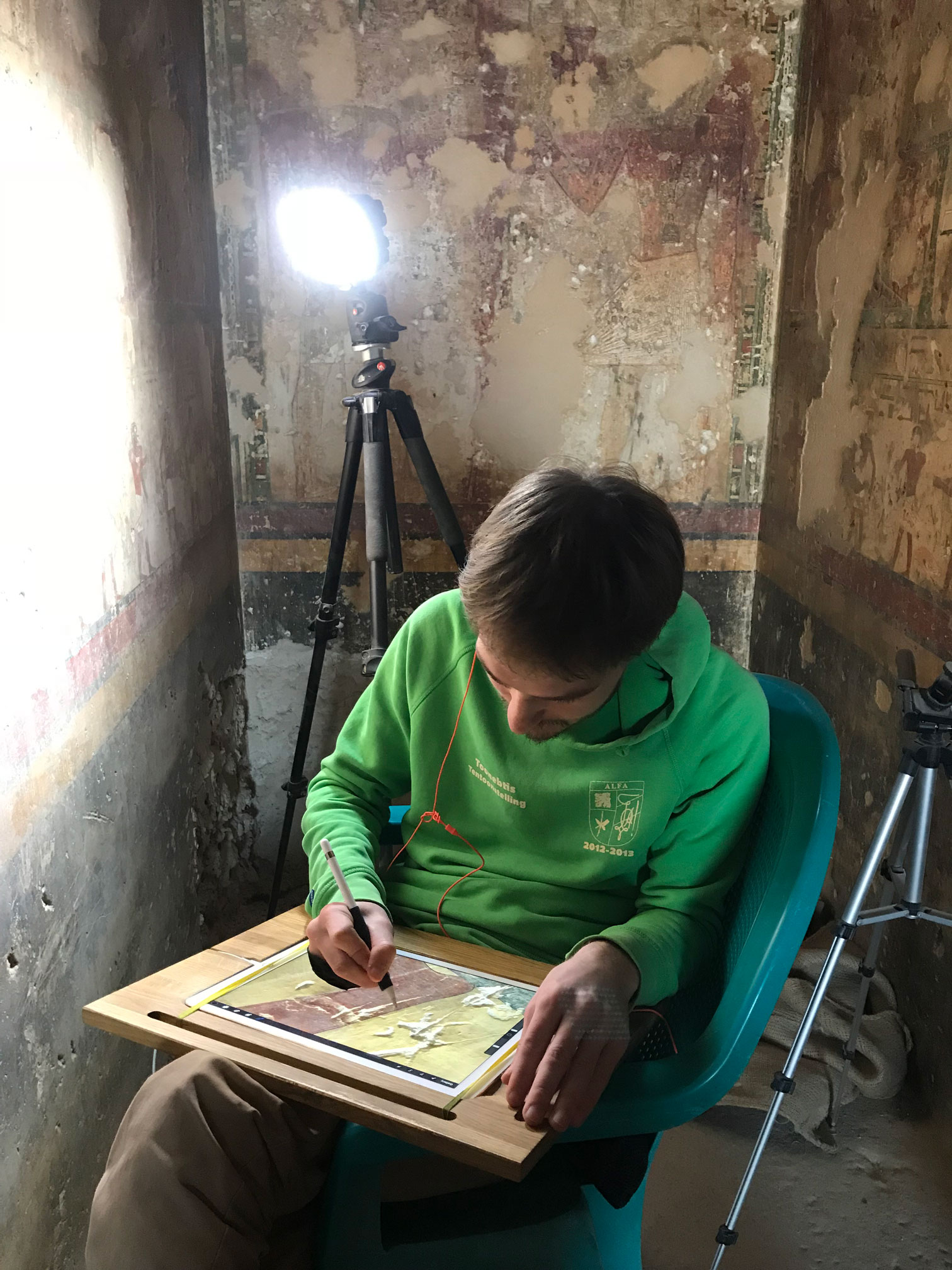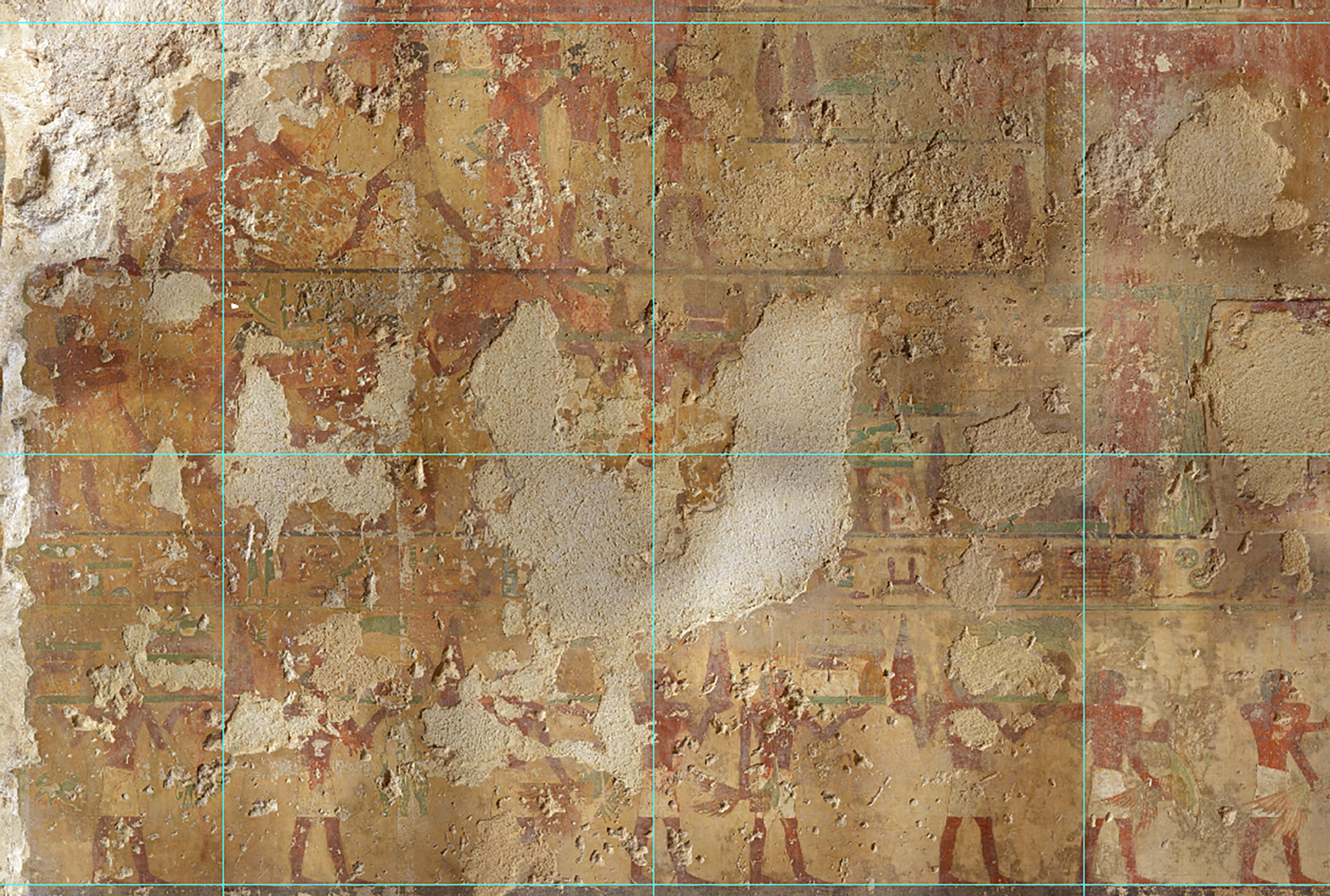Recording Djehutihotep. Digital epigraphy in a Middle Kingdom governor’s tomb at Dayr al-Barsha (Part 2)
From carbon to Bluetooth: Tracing the shrine’s painted scenes on the iPad
Written by Toon Sykora, KU Leuven, Department of Archaeology, PhD student
This Cave is full of Images in the Walls […]
These Characters, and Figures, are so numerous,
that they are not to be drawn by any in less than a Month’s time.
Johann Michael Wansleben (1673),
giving the oldest known description of the tomb of Djehutihotep[1]
After our preliminary study was completed (see Part 1), we set out to fully document the preserved decoration in the tomb of Djehutihotep. With originally more than 250 m² of painted surface and a high degree of detail in the decoration (Fig. 1), this poses quite a challenge. To further complicate the matter, several phases of destruction prevent an unobstructed view of the decoration. These destructions already started in the pharaonic era, when quarrying in and around the Middle Kingdom tombs caused major fractures and partial collapse of the rock-cut tombs. The remaining scenes were mutilated even further with chisel and paintbrush when the tomb was converted into a Coptic church and were not spared of further damage under the activities of antiquities looters from the 19th century onwards (Fig. 2). As a consequence, the project required a flexible methodology, which incorporates several layers of information and is easy to use in the field. Following Krisztián Vértes’s methodology for digital epigraphy, and with his highly valued support, a workflow was created that catered to our needs. Let us focus our attention on the shrine in the north wall of the inner chapel of Djehutihotep as an illustrative case study.

Fig. 1: Detail of an offering bearer holding two birds (shrine in the rear wall of the tomb of Djehutihotep)

Fig. 2: Detail from the shrine in the tomb of Djehutihotep, showing Coptic crosses painted over the original decoration
Djehutihotep’s funerary chapel contains a sizable offering shrine with almost 20m² of painted decoration. This shrine, cut into the centre of the north wall (Fig. 3), is dedicated to the tomb owner Djehutihotep and his father Kay. Both men are depicted on its walls while they are receiving offerings. Although these scenes are common in subject matter, they contain some of the most carefully painted and best-preserved decoration of the entire tomb, making this shrine an excellent candidate for showcasing the applied methodology.
Fig. 3: The north wall of the tomb of Djehutihotep with the shrine in its center
An orthorectified photographic image forms the base of our digital drawings. For each of the side walls of the shrine, over 200 images were used to create the orthophoto in Agisoft PhotoScan. This orthophoto was then scaled using on-site measurements. Any areas which may have been blurred or distorted in the orthophoto, were manually corrected by aligning clearer photographs with the underlying orthophoto.
In addition to the orthophotos, we use a large set of close-up images taken with a 60mm macro lens on a DSLR, which at full size give a magnification of the decoration that is impossible to achieve with the naked eye. These close-ups allow us to really catch every detail that the ancient artist created with his brush.
We take this orthophoto on site to create our initial drawing (equivalent of the old ‘pencil drawing’) on an iPad Pro (Fig. 4). The software we use for this, is the economically priced but incredibly versatile app Procreate. Embedding the iPad in a custom-made wooden drawing board gives us the stability we need on site. While this workflow works well in general, there is one drawback, namely the incapability of the iPad to work with large files. This forces us to adjust our files to the capacity of the iPad, so we divide our base-image along a 50 x 50 cm grid (Fig. 5). These individual squares – with some overlap to facilitate later realignment – are then exported to Procreate and used as the background for tracing.

Fig. 4: Epigraphic work in progress in the shrine of the tomb of Djehutihotep

Fig. 5: 50 x 50 cm squares applied to the orthophoto of part of the west wall of the shrine
After this preparatory stage, the drawing itself begins. The initial drawing is ideally produced in front of the original wall, giving the epigrapher the opportunity to perform a reality-check should a segment be insufficiently clear on the photograph. Especially with relief and badly preserved decoration, this is essential. Procreate allows up to 6 layers in a drawing, which we use to divide painted decoration, relief, grid lines, damage and Coptic crosses on separate layers (Fig. 6). The resulting multilayer image forms the best possible documentation of these walls.
Fig. 6: Animation showing the various layers of information recorded on the iPad (orthophoto, painted decoration, relief decoration, grid lines, damage, Coptic crosses)
All our initial drawings are collated on site by at least one other Egyptologist. When the tracings have been reworked to the satisfaction of both the initial and the collating epigraphers, the drawings are finalized in the digital inking process in Adobe Photoshop. At this stage a trait de force is added for relief decoration, as well as grayscales or patterns to indicate the various colours. While this entire process is very time-consuming, we believe that the final result is worth the effort and will create a documentation that will stand the test of time.
The 3D imaging techniques we employ to virtually reconstruct the tombs will be described in Part 3 by Roberto de Lima Hernandez.
Further reading
de Lima Hernandez, Roberto, Toon Sykora, Marleen De Meyer, Harco Willems and Maarten Vergauwen, On Combining Epigraphy, TLS, Photogrammetry, and Interactive Media for Heritage Documentation: The Case Study of Djehutihotep’s Tomb in Dayr al-Barsha. In: Proceedings of the EUROGRAPHICS Workshop on Graphics and Cultural Heritage, Vienna [2018], 225-227.
[1] Wansleben, Johann M., The Present State of Egypt: Or, a New Relation of a Late Voyage into that Kingdom: Performed int he Years 1672 and 1673 by F. Vansleb, R. D. wherein you have an Exact and True Account of Many Rare and Wonderful Particulars of that Ancient Kingdom: Englished by M.D. B.D., London [1678], 238-239.



0 comment(s)
Leave a comment(We'll keep your email address private)